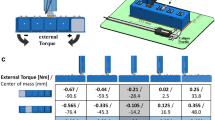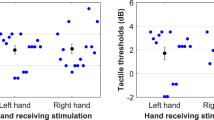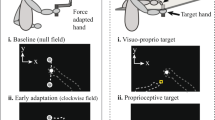Abstract
Sensory information about object properties, such as size or material, can be used to make an estimate of object weight and to generate an accurate motor plan to lift the object. When object properties change, the motor plan needs to be corrected based on the new information. The current study investigated whether such corrections could be made quickly, after the movement was initiated. Participants had to grasp and lift objects of different weights that could be indicated with different cues. During the reaching phase, the cue could change to indicate a different weight and participants had to quickly adjust their planned forces in order to lift the object skilfully. The object weight was cued with different object sizes (Experiment 1) or materials (Experiment 2) and the cue was presented in different sensory modality conditions: visually, haptically or both (visuohaptic). Results showed that participants could adjust their planned forces based on both size and material. Furthermore, corrections could be made in the visual, haptic and visuohaptic conditions, although the multisensory condition did not outperform the conditions with one sensory modality. These results suggest that motor plans can be quickly corrected based on sensory information about object properties from different sensory modalities. These findings provide insights into the information that can be shared between brain areas for the online control of hand-object interactions.




Similar content being viewed by others
Data availability
All data used for analyses and figures can be found at https://osf.io/d2afe/.
References
Ameli M, Dafotakis M, Fink GR, Nowak DA (2008) Predictive force programming in the grip-lift task: the role of memory links between arbitrary cues and object weight. Neuropsychologia 46:2383–2388. https://doi.org/10.1016/j.neuropsychologia.2008.03.011
Bergmann Tiest WM, Kappers AML (2014) The influence of material cues on early grasping force. In: Auvray M, Duriez C (eds) vol 8618. Springer Verlag, Berlin, pp 393–399
Betti S, Castiello U, Begliomini C (2021) Reach-to-grasp: a multisensory experience. Front Psychol 12:213
Borra E, Belmalih A, Calzavara R, Gerbella M, Murata A, Rozzi S, Luppino G (2008) Cortical connections of the macaque anterior intraparietal (AIP) area. Cereb Cortex 18:1094–1111. https://doi.org/10.1093/cercor/bhm146
Brouwer AM, Georgiou I, Glover S, Castiello U (2006) Adjusting reach to lift movements to sudden visible changes in target’s weight. Exp Brain Res 173:629–636. https://doi.org/10.1007/s00221-006-0406-x
Buckingham G, Cant JS, Goodale MA (2009) Living in a material world: how visual cues to material properties affect the way that we lift objects and perceive their weight. J Neurophysiol 102:3111–3118. https://doi.org/10.1152/jn.00515.2009
Budisavljevic S, Dell’Acqua F, Castiello U (2018) Cross-talk connections underlying dorsal and ventral stream integration during hand actions. Cortex 103:224–239. https://doi.org/10.1016/j.cortex.2018.02.016
Camponogara I, Volcic R (2019) Grasping movements toward seen and handheld objects. Sci Rep 9:3665. https://doi.org/10.1038/s41598-018-38277-w
Cant JS, Arnott SR, Goodale MA (2009) fMR-adaptation reveals separate processing regions for the perception of form and texture in the human ventral stream. Exp Brain Res 192:391–405. https://doi.org/10.1007/s00221-008-1573-8
Chang EC, Flanagan JR, Goodale MA (2008) The intermanual transfer of anticipatory force control in precision grip lifting is not influenced by the perception of weight. Exp Brain Res 185:319–329. https://doi.org/10.1007/s00221-007-1156-0
Chouinard PA, Leonard G, Paus T (2005) Role of the primary motor and dorsal premotor cortices in the anticipation of forces during object lifting. J Neurosci 25:2277–2284. https://doi.org/10.1523/JNEUROSCI.4649-04.2005
Chouinard PA, Large ME, Chang EC, Goodale MA (2009) Dissociable neural mechanisms for determining the perceived heaviness of objects and the predicted weight of objects during lifting: an fMRI investigation of the size-weight illusion. Neuroimage 44:200–212. https://doi.org/10.1016/j.neuroimage.2008.08.023
Cloutman LL (2013) Interaction between dorsal and ventral processing streams: where, when and how? Brain Lang 127:251–263. https://doi.org/10.1016/j.bandl.2012.08.003
Crevecoeur F, Munoz DP, Scott SH (2016) Dynamic multisensory integration: somatosensory speed trumps visual accuracy during feedback control. J Neurosci 36:8598–8611. https://doi.org/10.1523/JNEUROSCI.0184-16.2016
de Pascale M, Prattichizzo D (2007) The Haptik library: a component based architecture for uniform access to haptic devices. IEEE Robot Autom Mag 14:64–75
Dijkerman HC, de Haan EH (2007) Somatosensory processes subserving perception and action. Behav Brain Sci 30:189–201. https://doi.org/10.1017/S0140525X07001392
Distler C, Boussaoud D, Desimone R, Ungerleider LG (1993) Cortical connections of inferior temporal area TEO in macaque monkeys. J Comp Neurol 334:125–150. https://doi.org/10.1002/cne.903340111
Ernst MO, Banks MS (2002) Humans integrate visual and haptic information in a statistically optimal fashion. Nature 415:429–433. https://doi.org/10.1038/415429a
Fu Q, Zhang W, Santello M (2010) Anticipatory planning and control of grasp positions and forces for dexterous two-digit manipulation. J Neurosci 30:9117–9126. https://doi.org/10.1523/JNEUROSCI.4159-09.2010
Gallivan JP, Cant JS, Goodale MA, Flanagan JR (2014) Representation of object weight in human ventral visual cortex. Curr Biol 24:1866–1873. https://doi.org/10.1016/j.cub.2014.06.046
Goodale MA, Milner AD (1992) Seperate visual pathways for perception and action. Trends Neurosci 15:20–25
Gordon AM, Forssberg H, Johansson RS, Westling G (1991a) The integration of haptically acquired size information in the programming of precision grip. Exp Brain Res 83:483–488
Gordon AM, Forssberg H, Johansson RS, Westling G (1991b) Visual size cues in the programming of manipulative forces during precision grip. Exp Brain Res 83:477–482
Gordon AM, Forssberg H, Iwasaki N (1994) Formation and lateralization of internal representations underlying motor commands during precision grip. Neuropsychologia 32:555–568. https://doi.org/10.1016/0028-3932(94)90144-9
James TW, Kim S, Fisher JS (2007) The neural basis of haptic object processing. Can J Exp Psychol Revue Canadienne De Psychologie Expérimentale 61:219–229. https://doi.org/10.1037/cjep2007023
Jeffreys H (1939/1961) The theory of probability. Oxford University Press, Oxford
Johansson RS, Flanagan JR (2009) Coding and use of tactile signals from the fingertips in object manipulation tasks. Nat Rev Neurosci 10:345–359. https://doi.org/10.1038/nrn2621
Johansson RS, Westling G (1984) Roles of glabrous skin receptors and sensorimotor memory in automatic control of precision grip when lifting rougher or more slippery objects. Exp Brain Res 56:550–564
Johansson RS, Westling G (1988) Coordinated isometric muscle commands adequately and erroneously programmed for the weight during lifting task with precision grip. Exp Brain Res 71:59–71. https://doi.org/10.1007/BF00247522
Kim T, Bair W, Pasupathy A (2019) Neural coding for shape and texture in macaque area V4. J Neurosci 39:3073–3018. https://doi.org/10.1523/JNEUROSCI.3073-18.2019
Loh MN, Kirsch L, Rothwell JC, Lemon RN, Davare M (2010) Information about the weight of grasped objects from vision and internal models interacts within the primary motor cortex. J Neurosci 30:6984–6990. https://doi.org/10.1523/JNEUROSCI.6207-09.2010
Milner AD (2017) How do the two visual streams interact with each other? Exp Brain Res. https://doi.org/10.1007/s00221-017-4917-4
Milner AD, Goodale MA (2008) Two visual systems re-viewed. Neuropsychologia 46:774–785. https://doi.org/10.1016/j.neuropsychologia.2007.10.005
Monaco S, Sedda A, Cavina-Pratesi C, Culham JC (2015) Neural correlates of object size and object location during grasping actions. Eur J Neurosci 41:454–465. https://doi.org/10.1111/ejn.12786
Murata A, Gallese V, Luppino G, Kaseda M, Sakata H (2000) Selectivity for the shape, size, and orientation of objects for grasping in neurons of monkey parietal area AIP. J Neurophysiol 83:2580–2601. https://doi.org/10.1152/jn.2000.83.5.2580
Oldfield RC (1971) The assessment and analysis of handedness: the Edinburgh inventory. Neuropsychologia 9:97–113. https://doi.org/10.1016/0028-3932(71)90067-4
Takemura H, Rokem A, Winawer J, Yeatman JD, Wandell BA, Pestilli F (2016) A major human white matter pathway between dorsal and ventral visual cortex. Cereb Cortex 26:2205–2214. https://doi.org/10.1093/cercor/bhv064
van Polanen V, Davare M (2015a) Interactions between dorsal and ventral streams for controlling skilled grasp. Neuropsychologia 79:186–191. https://doi.org/10.1016/j.neuropsychologia.2015.07.010
van Polanen V, Davare M (2015b) Sensorimotor memory biases weight perception during object lifting. Front Hum Neurosci 9:700. https://doi.org/10.3389/fnhum.2015.00700
van Nuenen BFL, Kuhtz-Buschbeck J, Schulz C, Bloem BR, Siebner HR (2012) Weight-specific anticipatory coding of grip force in human dorsal premotor cortex. J Neurosci 32:5272–5283. https://doi.org/10.1523/JNEUROSCI.5673-11.2012
van Polanen V, Tibold R, Nuruki A, Davare M (2019) Visual delay affects force scaling and weight perception during object lifting in virtual reality. J Neurophysiol 121:1398–1409. https://doi.org/10.1152/jn.00396.2018
van Polanen V, Rens G, Davare M (2020) The role of the anterior intraparietal sulcus and the lateral occipital cortex in fingertip force scaling and weight perception during object lifting. J Neurophysiol 124:557–573. https://doi.org/10.1152/jn.00771.2019
Acknowledgements
The author would like to thank Silke Thys for her help in data collection for Experiment 2 and Guy Rens for providing comments to an earlier version of the manuscript.
Funding
This study was funded by Fonds Wetenschappelijk Onderzoek (Grant no. 12X7118N).
Author information
Authors and Affiliations
Corresponding author
Ethics declarations
Conflict of interest
The author declares no competing interests.
Additional information
Communicated by Melvyn A. Goodale.
Publisher's Note
Springer Nature remains neutral with regard to jurisdictional claims in published maps and institutional affiliations.
Rights and permissions
About this article
Cite this article
van Polanen, V. Multisensory information about changing object properties can be used to quickly correct predictive force scaling for object lifting. Exp Brain Res 240, 2121–2133 (2022). https://doi.org/10.1007/s00221-022-06404-9
Received:
Accepted:
Published:
Issue Date:
DOI: https://doi.org/10.1007/s00221-022-06404-9




